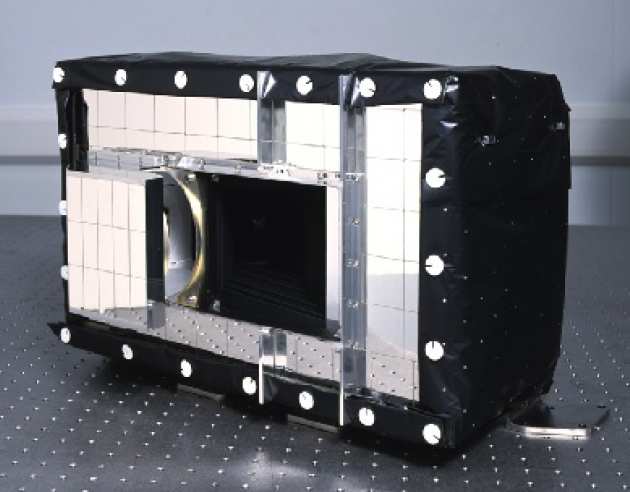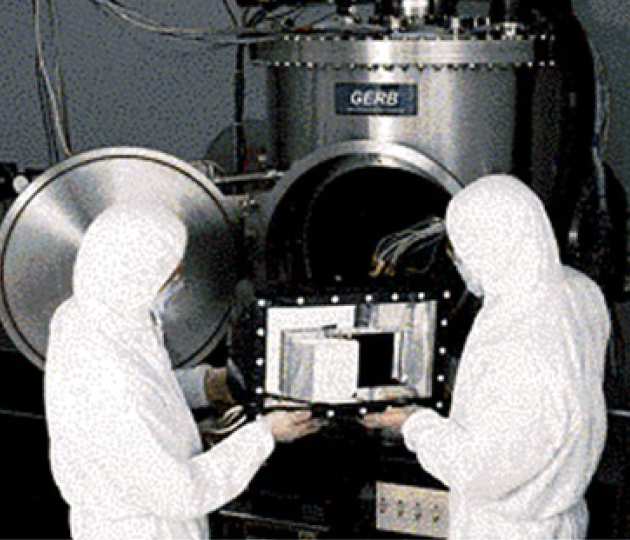Instrument
GERB Instrument
GERB Instrument Design
 GERB is a small, accurately calibrated radiometer that sits near the edge of MSG (since MSG spins at 100rpm, this produces an acceleration on GERB and all its parts of 18g!). GERB is about 45 x 20 x 15 cm in size, and weighs about 40 kg. A de-spin mirror reflects radiation towards a linear array of detectors, which take measurements along a north-south swath of the earth. The mirror is designed such that each subsequent measurement moves in the east-west direction, so that a full disc of the earth is sampled at a spatial resolution of approximately 50km2 over the course of about 5 minutes. Three of these measurements are then averaged to increase the signal-to-noise ratio and to facilitate co-registration with SEVIRI, which provides high resolution imagery at 15 minute intervals. This is the main operational instrument on board the MSG satellite and comparison with the higher resolution imagery from this instrument will allow better cloud-tracking and scene identification for GERB data analysis.
GERB is a small, accurately calibrated radiometer that sits near the edge of MSG (since MSG spins at 100rpm, this produces an acceleration on GERB and all its parts of 18g!). GERB is about 45 x 20 x 15 cm in size, and weighs about 40 kg. A de-spin mirror reflects radiation towards a linear array of detectors, which take measurements along a north-south swath of the earth. The mirror is designed such that each subsequent measurement moves in the east-west direction, so that a full disc of the earth is sampled at a spatial resolution of approximately 50km2 over the course of about 5 minutes. Three of these measurements are then averaged to increase the signal-to-noise ratio and to facilitate co-registration with SEVIRI, which provides high resolution imagery at 15 minute intervals. This is the main operational instrument on board the MSG satellite and comparison with the higher resolution imagery from this instrument will allow better cloud-tracking and scene identification for GERB data analysis.
The GERB instrument is designed to measure broad-band radiances exiting from the Earth to a very high accuracy (infrared < 1%, solar < 0.5%). To do this, the total radiation (over a bandpass from 0.32 to 30µm) is first measured, then a quartz filter is placed in the field of view of the instrument, allowing the solar component (wavelengths < 4µm) of the radiation through. The Earth's thermal, or longwave, radiation is then found by subtracting the shortwave from the total amount.
GERB Pre-Flight Calibration
 The importance of calibration is paramount as poorly calibrated data is useless to scientists and other end-users. Pre-flight ground calibration of the 3 GERB sensors built to date has been carried out at the Earth Observation Calibration Facility (EOCF ) of Imperial College. The goals of the pre-flight calibration are to measure the instrument's gains in the 2 channels; the full field-of-view (FOV) response function; the performance and characteristics of the on-board calibration sources; and the spectral response of the instrument with and without the quartz filter. Calibration algorithms are produced to convert raw data to filtered radiances, the level 1 data product.
The importance of calibration is paramount as poorly calibrated data is useless to scientists and other end-users. Pre-flight ground calibration of the 3 GERB sensors built to date has been carried out at the Earth Observation Calibration Facility (EOCF ) of Imperial College. The goals of the pre-flight calibration are to measure the instrument's gains in the 2 channels; the full field-of-view (FOV) response function; the performance and characteristics of the on-board calibration sources; and the spectral response of the instrument with and without the quartz filter. Calibration algorithms are produced to convert raw data to filtered radiances, the level 1 data product.
GERB In-Flight Calibration
As well as pre-flight calibration, continuous monitoring of data quality over the life of the mission in orbit is made possible by an on-board blackbody source and a solar transmission diffuser. A deep space look is used for zero reference. Measurements of the on-board blackbody are made during every rotation of the satellite, i.e. for each measurement, to ensure accuracy requirements are met. The solar diffuser is deployed on a regular basis to determine changes in the shortwave measurements due to drift or degradation of the optics. Other calibration plans include using the moon as a reference and using particular ground sites to characterise changes in the point spread function, for example.


